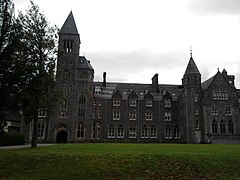Fort Augustus Abbey
| St. Benedict's Abbey | |
|---|---|
 |
|
| Alternative names | Fort Augustus Abbey |
| General information | |
| Type | Benedictine monastery |
| Town or city | Fort Augustus, Inverness-shire |
| Country | Scotland |
| Coordinates | 57°08′42″N 4°40′34″W / 57.145°N 4.676°WCoordinates: 57°08′42″N 4°40′34″W / 57.145°N 4.676°W |
| Construction started | 1876 |
| Completed | 1880 |
Fort Augustus Abbey, properly St. Benedict's Abbey, at Fort Augustus, Inverness-shire, Scotland, was a Benedictine monastery, from late in the nineteenth century to 1998.
It owed its inception to the desire of John Crichton-Stuart, 3rd Marquess of Bute, for the restoration of monasticism in Scotland. The marquess brought the matter before the superiors of the Anglo-Benedictine Congregation in 1874, promising substantial pecuniary help in the establishment of a house in Scotland, with the understanding that when two other monasteries should have been founded they should all form a separate Scottish congregation. The suggestion was approved of, and the Anglo-Benedictine authorities resolved to incorporate with the Scottish monastery Lamspringe Abbey, in Hanover, which was manned by English monks from 1645 to 1803.
Inadequacy of funds had prevented any lasting restoration of this house, but with the help promised by Lord Bute, it seemed possible to revive it in Scotland. Dom Jerome Vaughan, a brother of Cardinal Vaughan, was appointed to superintend the work, and succeeded in collecting from rich and poor in England, Scotland, and Ireland, sufficient means for the erection of a fine monastery a cost of some £70,000.
The site at Fort Augustus was given by Simon Fraser, 13th Lord Lovat. It comprised the buildings of a dismantled fort, built in 1729 and originally erected for the suppression of Highland Jacobites. It had been purchased from the Government by the Lovat family, in 1867.
The monastic buildings begun in 1876 were completed in 1880, occupying the four sides of a quadrangle about one hundred feet square. In one wing a school for boys of the upper classes was conducted by the monks, with lay masters, for about sixteen years.
Up to the year 1882 St. Benedict's monastery remained under the jurisdiction of the Anglo-Benedictine Congregation, but in response to the wishes of the Scottish hierarchy, and of the leading Scottish nobility—notably Lords Lovat and Bute—Pope Leo XIII, by his Brief "Summâ cum animi lætitiâ", dated 12 December 1882, erected it into an independent abbey, immediately subject to the Holy See, thus separating it from English rule. When this step had been accomplished, Lord Lovat made over the property to the Scottish community, by signing the title deeds, which for a time had been held over.
...
Wikipedia
